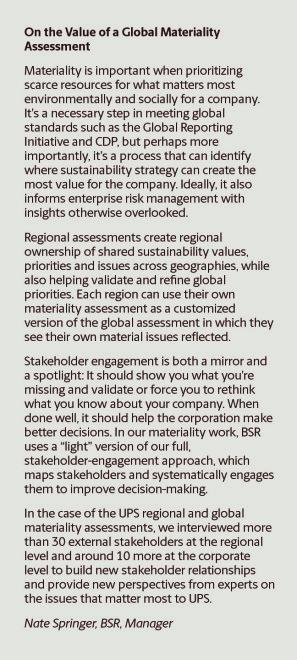Living in a Materiality World
Here are four guiding principles for companies embarking on their first materiality assessment

Ed Rogers | UPS
While mega-trends such as urbanization, the digital economy, population growth and a rising global middle class have become a focal point for companies seeking to develop sustainable growth strategies, in reality the world is far more nuanced and complex than most companies are prepared to admit.
Many large companies use an enterprise risk-management process to assess key business risks and develop strategies to mitigate the likelihood and impact of relevant issues. But perhaps that’s not enough.
In addition to growing interest from customers wanting to better understand company business practices, there has been a rise in demand by investors seeking environmental, social and governance (ESG) disclosures. Increasingly, companies are turning to materiality assessments to better navigate stakeholder expectations.
The insights garnered from these assessments can be used to guide a company’s sustainability strategy, as well as allow businesses to identify hot-button issues, helping them stay ahead of regulations, employee expectations, marketplace trends and emerging global issues.
As part of our sustainability strategy process, UPS recently conducted a comprehensive materiality assessment to gain insight into key sustainability issues important to our stakeholders, both inside and outside our company.
We examined more than 50 issues, including areas of significant organizational impact, as well as broader sustainability trends relevant to our business. We evaluated each issue’s relative importance to our stakeholders, as well as our long-term business success.
The result was a sharper picture of our sustainability issues, challenges and opportunities.
A U.S. lens is not enough
However, the process should not end here. By conducting a materiality assessment through a predominantly U.S. lens, companies may find it fails to capture the variations that occur within a business’s larger global footprint.
To address this, businesses should go a step further and complete separate materiality assessments for each of their key operating regions, as we did, so that these results can be used to build out a truly global assessment.
Companies should cross-check the highest-ranking sustainability issues against their enterprise risk-management process to determine if there are any underestimated risks.
In the end, the goal of this process is to identify opportunities that further refine an organization’s business and reporting strategies. In tandem, companies can use the information to help inform future sustainability initiatives and support overarching sustainability goal-setting processes.
Four guiding principles
From establishing new dialogues with key stakeholders to better understanding key issues impacting business environments and customers, materiality assessments can play a prominent role in helping companies achieve business and sustainability objectives.
Based on our experience, I would recommend a few key guiding principles for a company embarking on its first materiality assessment:
1. Enlist an adviser
Identify a credible third-party sustainability expert with an understanding of your industry and business to be your partner. This will help ensure your research is conducted accurately and results are evaluated fairly and without internal bias.
2. Match perspective to footprint
If your company is serving a global customer base, you’ll benefit from having insight into the range of issues important to each market area and how the issues ratchet up to form your company’s operating environment.
3. Engage the right stakeholders
“Stakeholder engagement is both a mirror and a spotlight: It should show you what you’re missing and validate or force you to rethink what you know about your company,” says Nate Springer, a manager at BSR, whose team assisted UPS with its assessment.
Work with your third-party partner to identify and engage a multitude of stakeholders throughout the process, including customers, non-profit organizations, communities and governments in various geographies.
Additionally, ensure that internal managers and executives involved in the research process represent a cross-section of your organization, spanning geographies and functional areas to create a more balanced and accurate view.
4. Leverage Results for Impact
While insights gathered by your global materiality assessment will be important, the real value will lie in how your company uses the data to inform strategies.
The information gathered will provide a moment-in-time snapshot that will grow in importance as you move forward with your sustainability efforts, helping you track changes within your organization and operating environment that warrant further evaluation.
This article first appeared on Ethical Corporation and was republished with permission.
Ed Rogers is Senior Director of Global Sustainability for UPS.

